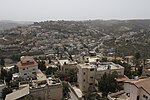Mishmar HaEmek (Hebrew: מִשְׁמַר הָעֵמֶק, lit. "Guard of the Valley") is a kibbutz in northern Israel. Located in the western Jezreel Valley, it falls under the jurisdiction of the Megiddo Regional Council. Mishmar HaEmek is one of the few kibbutzim that have not undergone privatization and still follow the traditional collectivist and socialist kibbutz model. In 2021, it had a population of 1,267. At least six former members of the Knesset hail from Mishmar HaEmek.
The area was acquired by the Jewish community as part of the Sursock Purchase. The kibbutz was established in 1926 by members of the HaShomer HaTzair ("The Young Guard") movement, who mostly came from Europe to Mandatory Palestine during the Third Aliyah. It was the first Jewish settlement in the southern part of the Jezreel Valley, built as part of Jewish National Fund efforts to settle the valley. It quickly became a center of HaShomer HaTzair, especially after the Kibbutz Arzi chose to build their first regional school in the kibbutz.
As a HaShomer HaTzair stronghold, the kibbutz housed many pioneers of other kibbutzim and instructed them before they established their own kibbutzim. In April 1948, during the 1947–48 Civil War in Mandatory Palestine, the kibbutz was the epicenter of the Battle of Mishmar HaEmek, successfully repelling the first major offensive of the Arab Liberation Army commanded by Fawzi al-Qawuqji.
The economy of the kibbutz has historically been focused on agriculture. Since 1950, it has also operated a plastics factory in partnership with Kibbutz Gal'ed, which has become a central part of the kibbutz's economy. The forest near the kibbutz was planted by its residents and is listed as a biosphere reserve by UNESCO. Two ancient settlements dating back to prehistoric times have been found in the vicinity of the kibbutz.












